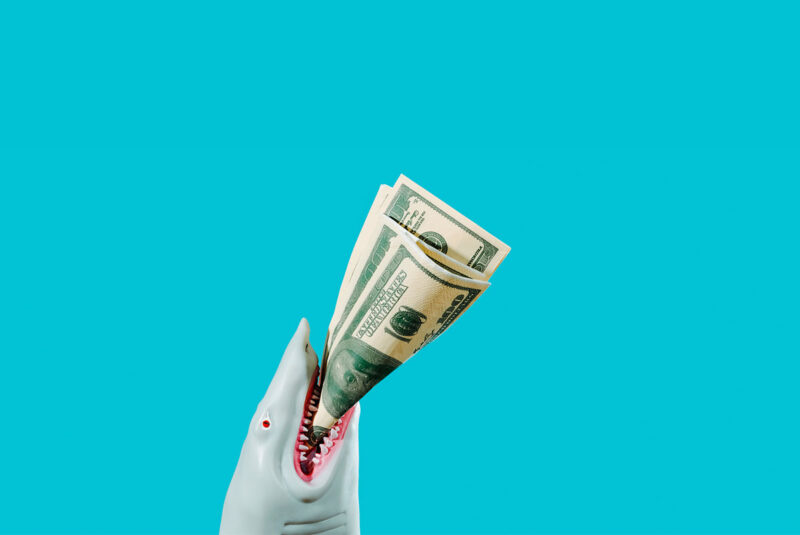Explore your mortgage options
The decision to apply for a personal line of credit vs. a personal loan can be complicated. While these borrowing options have many similarities, there are a few key differences that can work to your advantage or disadvantage, depending on your financial situation.
Let’s look at how personal lines of credit and personal loans operate to help you decide which option is right for you.
Need Cash?
Applying for a personal loan has never been easier. Get the cash you need with competitive terms from Rocket LoansSM.
Checking your options won’t affect your credit score.
What’s the Difference Between a Personal Line of Credit and a Personal Loan?
Personal loans come with a one-time disbursement, meaning they give you the loan amount upfront. They also typically have a fixed interest rate and a set repayment schedule that requires regular monthly payments.
Personal lines of credit are more flexible, as they allow you to borrow money as you need it and have you repay with a variable interest rate.
How Does a Personal Line of Credit Work?
A personal line of credit works like a credit card you can only use for a set period. You can borrow and pay interest on funds up to a credit limit, but once your draw period ends, you must focus on paying back the principal and interest before your repayment period ends.
Let’s look at how personal lines of credit work in a bit more detail.
Distribution method
A personal line of credit is revolving credit, so the distribution method is mainly up to you. You can take out as much money as you’d like up to your credit limit, much like a credit card. The lender determines the credit limit based on your credit score and income.
Borrowing limit
Your lender will determine how much you can borrow based on your credit score and income. The higher your credit score and the more income you earn, the better your chances are of a lender offering a high credit limit.
Interest rate
One great thing about a personal line of credit is that lenders only charge interest on the amount you withdraw. The downside is that personal lines of credit usually have higher interest rates than personal loans. Also, they typically have variable interest rates, which means the rates and your monthly payments can change.
Repayment timeline
Once your draw period ends, you can no longer withdraw money from your line of credit, and you can continue making monthly payments until the loan is paid off. This period typically lasts between 3 – 5 years.
Eligibility
Qualifying for a personal line of credit depends on the same factors as a personal loan: your credit score, payment history, income and debt-to-income (DTI) ratio.
Personal lines of credit require higher credit scores than personal loans, so you will need a minimum 670 credit score to qualify. The higher credit score you have, the better terms you will receive. Lenders will also need proof of income and employment to ensure you can repay the loan. Finally, a DTI of 36% or lower is ideal, but some lenders will work with you even if you have a DTI of up to 50%.
Upfront costs
Lenders may charge certain fees before you can access your line of credit. The origination fee will cover the expenses for credit underwriting and processing your application. There may also be an additional application fee. These costs differ between lenders, so make sure to compare them when you are shopping around.
Typical uses
A personal line of credit is good for ongoing or unpredictable, larger expenses, like home renovations or emergency funds. They may also help you pay for expenses when there are gaps in your income. A line of credit may be a better option than a personal loan if you have unpredictable income since you only repay it when/if you use it.
How Does a Personal Loan Work?
With a personal loan, you receive a lump sum at the beginning of your term and pay it off in fixed monthly installments. While this may sound straightforward, there are some important details you should know about personal loans:
Distribution Method
You receive a lump-sum payment from your lender and agree to repay the loan with interest over a set period.
Borrowing limit
Lenders set the borrowing limit for personal loans based on the same criteria as personal lines of credit: credit score, payment history, income and DTI ratio. A typical loan ranges from $2,000 – $45,000. However, some lenders specialize in micro-loans as low as $600, while others allow loans up to $100,000.
Interest rate
Because personal loans are typically unsecured, their interest rates tend to be higher than interest rates for secured loans. However, personal loans typically have lower interest rates than personal lines of credit.
Generally, a personal loan’s fixed interest rates range from 7.5% – 36%, but your rate will depend on your creditworthiness and the economic conditions when you apply. Interest starts accruing on the total loan amount from day one.
Repayment timeline
Personal loans have a fixed repayment period, typically 12 – 60 months, with fixed monthly payments.
Longer-term personal loans with repayment periods of up to 120 months do exist, but they’re much less common and tend to be harder to qualify for.
Eligibility
Qualifying for a personal loan depends on your credit score, payment history, income and DTI ratio. Many lenders require a minimum credit score in the mid-600s. That said, a score in the 700+ range will likely get much better terms. As with a personal line of credit, lenders will confirm your credit report, income, employment and DTI. As with personal lines of credit, an ideal DTI would be 36% or lower, but some lenders will work with you even if you have a DTI of up to 50%.
Upfront costs
Personal loans have similar upfront fees you must pay to receive the loan. These include the origination fee to cover lender expenses and an application fee.
Typical uses
A personal loan can be used for almost anything, including consolidating credit card debt, covering wedding costs or repaying medical expenses. Because you have a fixed interest rate and monthly payments, repayment is more predictable. Personal loans are generally better suited for borrowers with stable incomes.
See What You Prequalify For
Get prequalified offers for personal loans from Rocket LoansSM within seconds. Like what you see? Same-day funding is available.
Checking your options won’t affect your credit score.
Pros and Cons of a Personal Line of Credit
There are positive and negative attributes to personal lines of credit. Here are some of the most prominent.
Pros of a personal line of credit
- Flexible: You can use a line of credit for any purpose and tap into the funds as necessary.
- Pay as you go: You only pay interest on what you withdraw.
- Revolving credit: When you pay back what you withdraw or make the minimum monthly payment, you can continue to borrow.
- Quick turnaround: You may be able to get the loan in as little as 24 hours.
Cons of a personal line of credit
- Higher interest rates: You will typically pay higher rates than personal loans.
- Fees: You might have to pay fees if you don’t make your minimum monthly payment or make a late payment.
- Higher credit requirement: You may need a higher credit score to qualify for a personal line of credit than a personal loan.
- Restrictive draw period: The draw period typically lasts for 5 – 10 years.
Pros and Cons of a Personal Loan
There are also advantages and disadvantages to personal loans. Let’s take a look at both.
Pros of a personal loan
- Easier to manage: You may find fixed payments easier to budget for.
- Lower interest rate: You will typically pay lower rates than personal lines of credit.
- Flexible: You can use the funds for almost anything.
- Quick turnaround: You can usually get the money quickly.
Cons of a personal loan
- Pay interest on the entire amount: Even if you don’t use the funds immediately, interest accrues from day one on the entire loan amount.
- Fees: You may pay an origination fee, an application fee, a late payment fee, and there may even be a prepayment fee if you pay your loan off early.
- Fixed loan amount: If you need more money after taking out your loan, you’ll have to go through the application process again.
- Have to repay the entire amount: Even if you borrow more money than you use, you still have to repay the entire loan, including interest.
How to Apply for a Personal Line of Credit or Personal Loan
Before applying for any loan, it is essential to shop around to find the best deals and loan structures that fit your financial needs. Once you’ve decided whether to go with a personal line of credit or personal loan, you can apply online or in person at a lender’s office. The lender will look at your credit score, credit history, income and assets to decide whether to grant you the loan. The lender may approve you in as little as 24 hours, but it can take 7 – 10 days.
Alternatives to a Personal Line of Credit or Personal Loan
A personal line of credit or personal loan is not your only option. Let’s look at some alternatives that may better fit your financial situation.
Home Equity line of credit (HELOC)
A home equity line of credit (HELOC) is similar to a personal line of credit with one essential difference: HELOCs are secured by the equity in your home. This means you can get better interest rates, a larger loan and a longer payback period because the loan is less risky for lenders.
However, you must make payments on your HELOC on top of your original mortgage payments. If you fail to make these payments on time, you risk losing your home in foreclosure. A HELOC may be a good alternative if you need more money than you can qualify for with a personal loan or line of credit and want to take advantage of lower interest rates.
Credit Card
A credit card is also similar to a personal line of credit in that they are both revolving and unsecured. You can use both for a broad variety of purposes, tap into them whenever you’d like, and spend up to your credit limit. However, credit cards differ because they do not have draw periods and typically charge higher interest rates. Since you pay interest on your leftover balance in the next payment period, it is best to use a credit card for purchases you can pay off monthly so you do not have to pay interest.
Cash-out refinance
A cash-out refinance is another great way to use your home’s equity to receive the cash you need with more favorable terms than a personal line of credit or personal loan. With a cash-out refinance, you sign a new mortgage loan that lets you turn a portion of your home’s equity into cash. This new loan replaces your existing mortgage, so unlike a HELOC, you will only have one mortgage payment after the refinance. A cash-out refinance is great for someone who needs more money than they can get with a personal loan or personal line of credit but does not want to make two mortgage payments like with a HELOC.
Final Thoughts on Personal Lines of Credit vs. Personal Loans
When you know why you want to borrow money, what your current financial situation is and how you plan to repay the money you borrow, choosing between personal lines of credit and personal loans gets a lot easier.
Don’t rush into a decision. Take the time to weigh all your options so you can enjoy the fruits of your decision.
Get Prequalified for Loans from $2,000 to $45,000
Rocket LoansSM offers personal loans from $2,000 – $45,000. From debt consolidation to unexpected expenses, we’ve got you covered.
Checking your options won’t affect your credit score.
The Short Version
- Whether a personal line of credit or personal loan is the better option will be based on your financial situation
- The main differences between a line of credit and a personal loan are the loans’ terms and how you pay them back
- You’ll likely need a higher credit score to qualify for a line of credit than a personal loan. If you have a low credit score, a bad credit personal loan may be a better option




